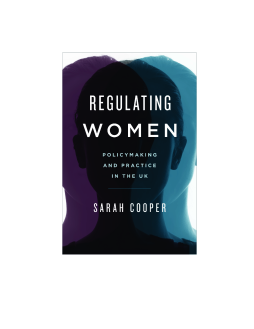
Additional Information
Book Details
Abstract
A number of women’s issues serve to create novel policy problems that require creative, and sometimes unique, regulatory and legal responses. This book embarks upon a comparative case study approach to explore UK policymaking in the areas of abortion, rape, prostitution and pornography in turn. Each chapter engages a different institutional perspective to explore the influence of a range of bodies such as the legal system, medical profession, civil society, police force and mass media. The analysis reveals a common thread that runs throughout decision-making in these areas; a constant balancing act between regulation that purports to protect women, and regulation that supposedly reflects female liberation, with a continual dance between the labels of ‘criminal’ and ‘victim’ being performed by policy actors.
Largely reflective of a dogmatic approach to the status of women, it is argued that different institutions retain strongholds over policymaking in these domains, prohibiting a joined-up approach. This has served to perpetuate harmful and negative stereotyping of women’s issues and create countless conundrums when the activities of women fall into more than one policy category.
Sarah Cooper is Lecturer in Politics at the University of Exeter.
By examining the regulation of women in the UK, this fine book is foremost about gender issues and policy-making in the national setting. It is, however, also of great interest to students and scholars of European studies as it convincingly shows how a policy-area of strong national institutions and legacies is influenced by and respond to European integration, be it due to the free movement of women as the abortion chapter demonstrates or the ways in which supranational law and the open internet influences the regulation of pornography.
Dorte Sindbjerg Martinsen, Deputy Head and Professor of Political Science, University of Copenhagen
A welcome and timely addition to scholarly research on women’s experiences in the political, policy and regulatory landscape. This tour de force covers a breadth of issues on the status of women in policy institutions, the regulation of abortion, pornography and gender based violence. It offers a uniquely multi-disciplinary perspective drawing upon historical, sociological, feminist, political and governance frameworks to offer new insights on the social exclusion of women. Cooper provides a sound, empirical evidence base for improving policy and the quality of life for women.
Karen Johnston, Professor of Politics and Public Policy, Glasgow Caledonian University
Table of Contents
| Section Title | Page | Action | Price |
|---|---|---|---|
| Contents | 7 | ||
| Acknowledgements | 9 | ||
| List of Abbreviations | 11 | ||
| 1 Analysing the Status of Women in UK Policymaking: How Do Institutions Matter? | 13 | ||
| 1.1. Institutional Legacies and Policymaking | 16 | ||
| 1.2. Addressing the Theoretical Core: Comparing Apples and Oranges? | 21 | ||
| 1.3. Operationalizing the Multi-Variant Approach | 24 | ||
| 1.4. Structure of the Book | 29 | ||
| Note | 32 | ||
| 2 Hanging on to the Old: Path Dependency in UK Abortion Regulation | 35 | ||
| 2.1. A Brief History: Crimes Against the Unborn 1200–1900 | 37 | ||
| 2.2. The 1967 Abortion Act | 40 | ||
| 2.3. A Healthcare Treatment or Criminal Act? | 43 | ||
| 2.4. Historical Barriers: Evidence-Based Policymaking and the Abortion Pill | 54 | ||
| 2.5. The European Capital for Abortion | 62 | ||
| 2.6. Conclusion | 67 | ||
| 3 Balancing Protection and Prosecution: The Rationality of UK Prostitution Legislation | 71 | ||
| 3.1. The Law on Prostitution: From ‘Street Offences’ to ‘Sexual Offences’ | 73 | ||
| 3.2. The Policing and Crime Act 2009 | 76 | ||
| 3.3. A Public Nuisance or a Question of Labour Rights? | 79 | ||
| 3.4. Political Self-Interest and Future Regulation: The Case of the Bradford Murders | 89 | ||
| 3.5. Deriving Inspiration from Overseas: Neo-Abolitionism in Europe | 97 | ||
| 3.6. Conclusion | 99 | ||
| 4 Demanding a ‘Proper Victim’: The Culture of Rape Policy in the UK | 101 | ||
| 4.1. Rape at Common Law: The Woman on Trial | 103 | ||
| 4.2. The Sexual Offences Act 2003 | 107 | ||
| 4.3. A Probable Criminal or a Likely Victim? | 109 | ||
| 4.4. Normative Order: The Fear of Coming Forward and Marital Rape | 123 | ||
| 4.5. Reaching International Standards of Regulation across the EU | 130 | ||
| 4.5. Conclusion | 133 | ||
| 5 Welcoming Public Debate: Developing the Regulation of Pornography through Open Discussion | 137 | ||
| 5.1. Regulating the Sale and Distribution of Pornography | 139 | ||
| 5.2. Cameron’s Crackdown | 143 | ||
| 5.3. Who Needs Protecting? | 146 | ||
| 5.4. Altering the Dominant Discourse: Linking Violent Crime and Pornography | 153 | ||
| 5.5. Supranational Law and the Open Internet | 160 | ||
| 5.6. Conclusion | 162 | ||
| 6 Conclusion: Harmful Stereotyping and Institutional Stronghold in the Regulation of Women’s Issues | 165 | ||
| 6.1. Shedding Light on the ‘Black Box’ | 167 | ||
| 6.2. Benefitting from a Multi-Variant Approach | 171 | ||
| 6.3. Dispelling the Myths: Lessons for Practitioners and Towards a Gendered Lens | 179 | ||
| Bibliography | 185 | ||
| Index | 209 |
